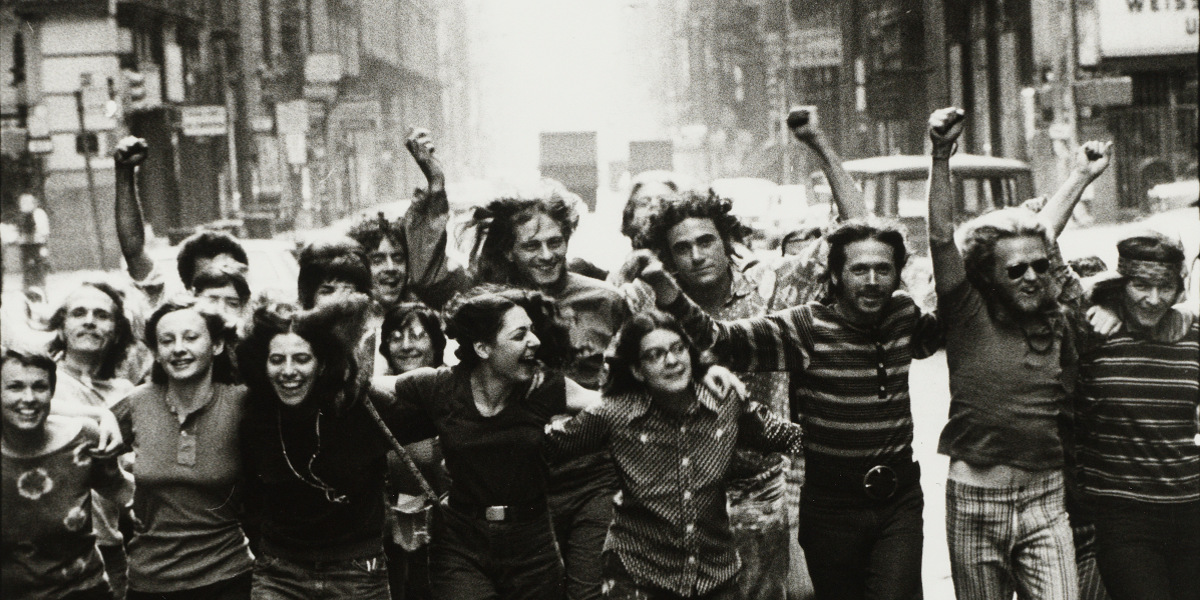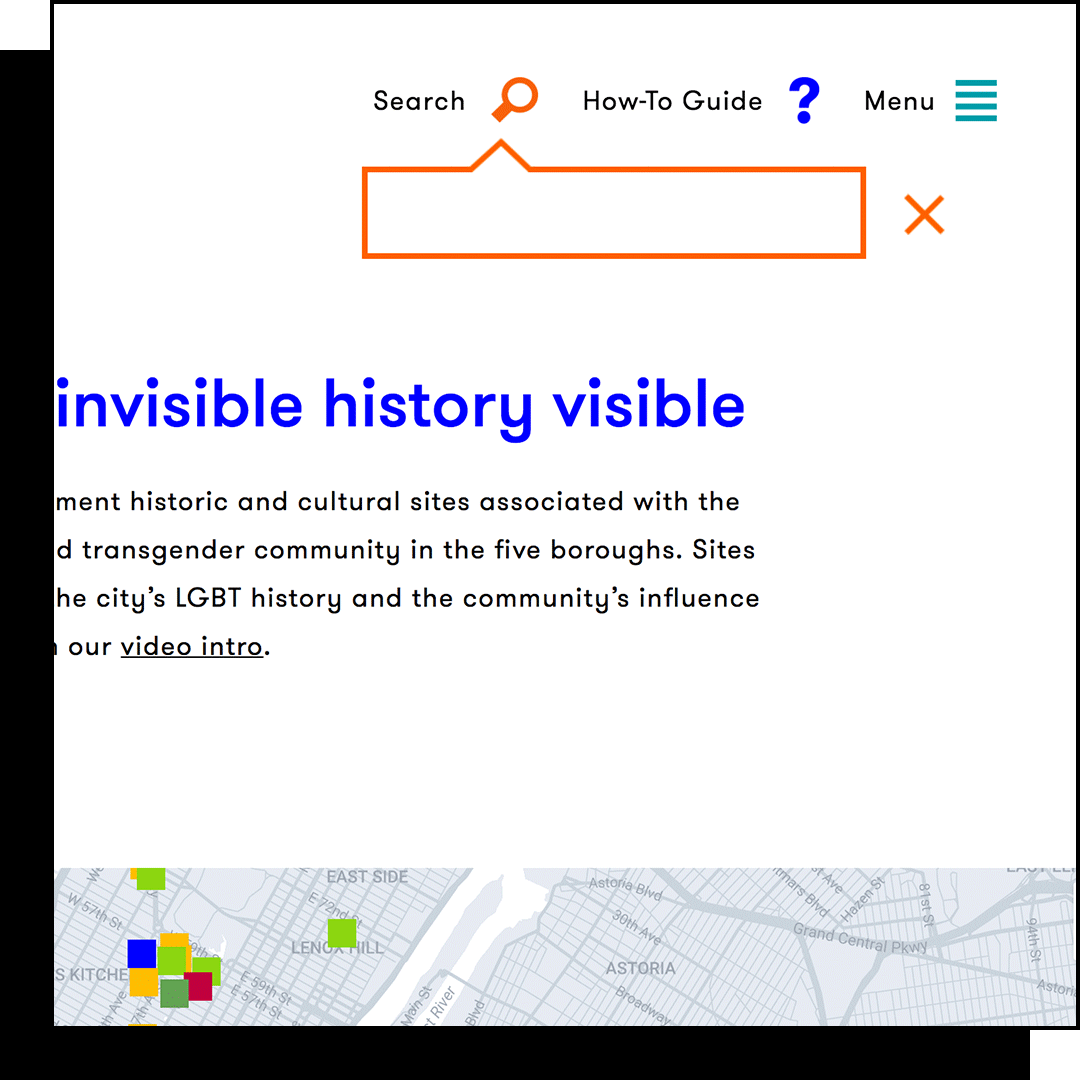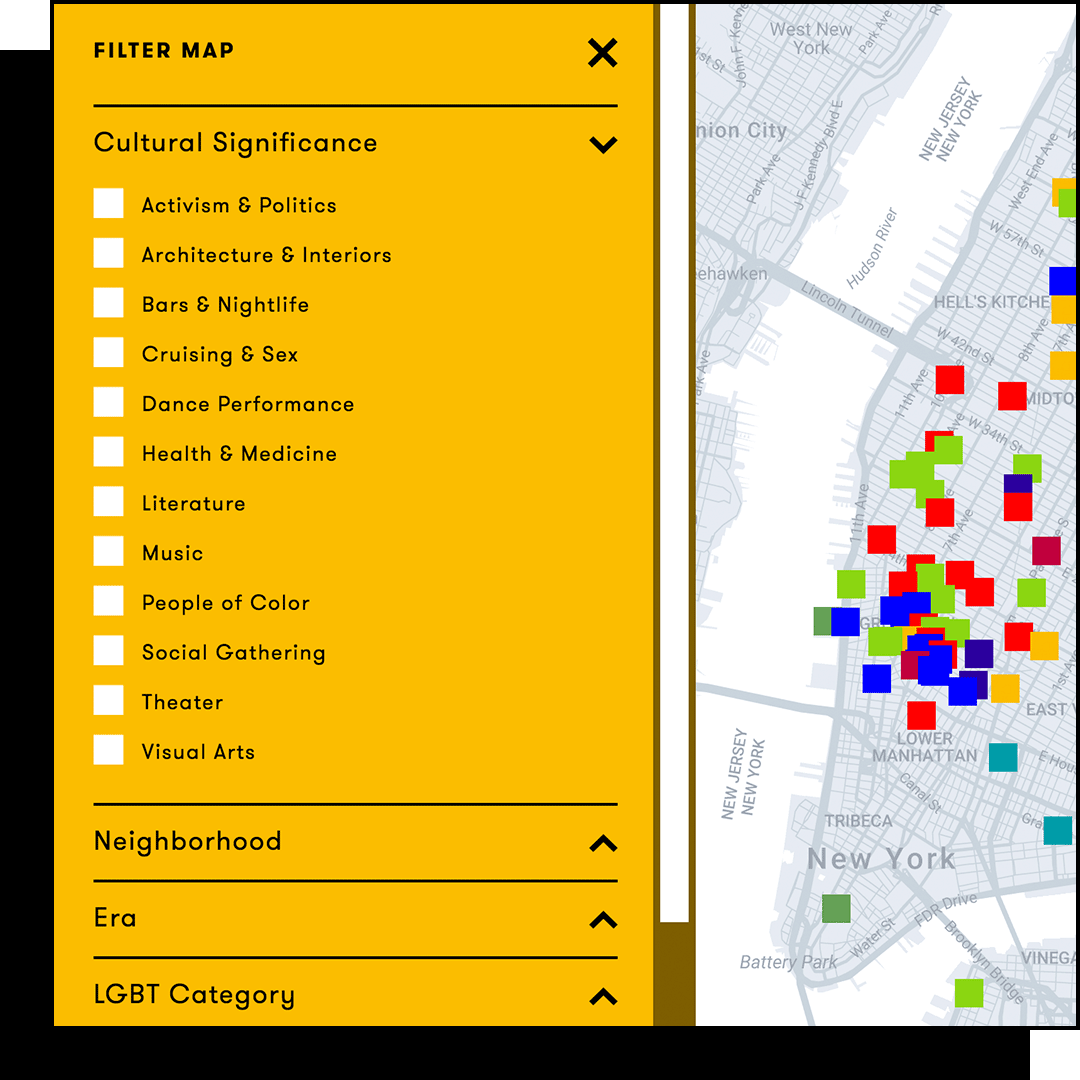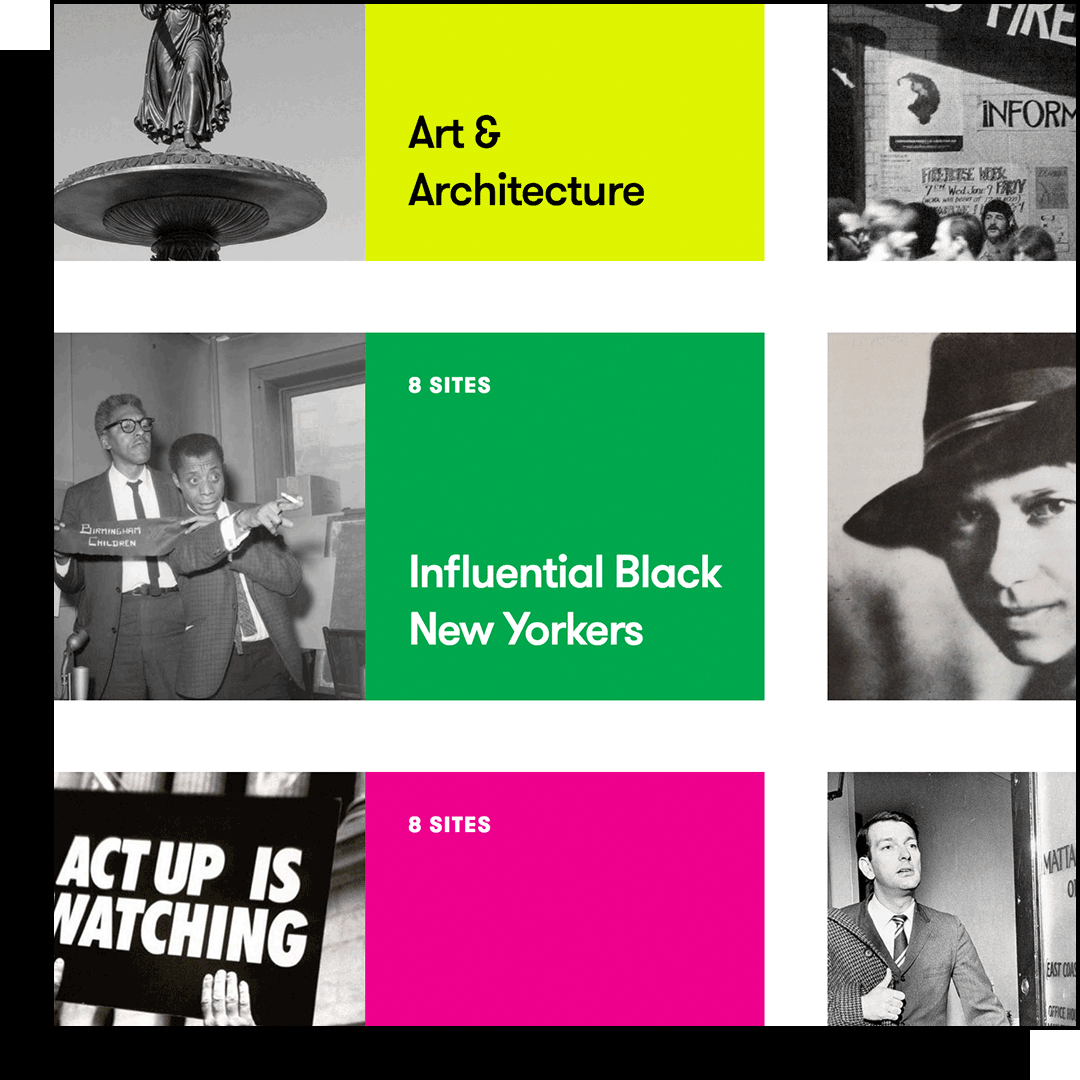
“Gay Liberation Front Poster Image, 1970.” First row: Lyn Farley, Stephanie Meyers, Gayle Russo, Judy Reif, Fran Winant, Steven Dansky, Jim Fouratt, Suzanne BeVier. Second row: Earl Galvin, Sue Schneider, unknown, unknown, Bob Bland, Carl Miller, Dan Smith, John Erdman, William Pigman. Third row: unknown. East 19th Street, crossing Fifth Avenue. © 1987 The Peter Hujar Archive LLC. Courtesy of Pace/MacGill Gallery, New York and Fraenkel Gallery, San Francisco.
How-To Guide
This website is a scholarly project meant to serve as an educational resource for anyone who is interested in learning more about existing historic and cultural sites associated with the lesbian, gay, bisexual, and transgender (LGBT) community in New York City. We are continuously adding sites after conducting thorough research. View list of all historic sites currently included on our website.
Entries have been written using various resources in order to be as accurate as possible in documenting each site’s LGBT significance. On historic site pages, the names of LGBT people are in bold. Due to the sensitive nature of identifying certain historical figures as LGBT, each site page (where applicable) includes scholarly sources and guidebooks that we referenced in determining the individual’s inclusion on our map.
Demolished sites will not appear on the map, but we are tracking them separately on an internal list.
Many of the sites featured on our website are privately owned and not open to the public. Please respect people’s privacy and do not trespass.
Skip to Section:
Search Features
Anyone using this website can dive right into the map and explore pins on their own.
At the top of the page you will also notice a magnifying glass icon that allows you to search the site by keywords. This will bring up thumbnail views of all related content, including news, events, and historic sites (which will be differentiated by its color-coded site type at the bottom of the thumbnail).

Filtering the Map
Historic sites have been tagged by Cultural Significance, Neighborhood, Era, and LGBT Category to help you search the map. In the yellow “filter results by” box on the homepage, you can choose as many tags as you want and then hit the “apply filters” button. Only historic sites on the map that fit your search criteria will remain.
This is also helpful if you are looking for something more specific. Choose “bars & nightlife” “1950s” “1960s” and “gay” to find where gay men were socializing in the two decades before the Stonewall uprising (narrow your search even further by choosing one or several neighborhoods or boroughs). Interested in seeing everything we have so far on transgender history, regardless of time or place? Just select the “transgender” tag.
The map will automatically zoom in or out to include all historic sites that match your search. Hover over a pin to get the basic information about the site or click on it to go to the site’s history page.

Cultural Significance
- Activism & Politics
Examples: Political Figures, Demonstrations/Zaps, Marches, Activist Organizations - Architecture & Interiors
Examples: Architects, Interior Designers, Historic Preservationists, Landscape Designers, Urban Planners - Bars & Nightlife
Examples: Drinking, Eating, Clubbing/Dancing - Cruising & Sex
Examples: Sexual Activity in Public Places (Bathhouses, Parks, Alleys, Sex Clubs, Beaches) - Dance Performance
Examples: Dancers, Dance Instructors, Choreographers - Health & Medicine
Examples: AIDS, Surgeries, Psychiatry, Doctors - Literature
Examples: Poets, Novelists, Writers, Journalists - Music
Examples: Composers/Conductors, Musicians, Singers - People of Color
Examples: African Americans, Latinos/as, Asian Americans - Social Gathering
Examples: Community Events, House Parties/Salons, Religious Worship - Theater
Examples: Performers, Playwrights, Directors, Producers, Designers - Visual Arts
Examples: Painters, Sculptors, Photographers, Muralists, Fashion Designers, Film Actors, Film Directors, Film Producers, Film Designers
Type of Historic Site
- Bars, Clubs & Restaurants
Examples: Bars, Nightclubs, Sex Clubs, Restaurants, Cafés - Cultural & Educational Institutions
Examples: Museums, Schools/Universities, Archives, Libraries - Medical Facilities
Examples: Hospitals, Hospices, Nursing Homes, Doctor’s Offices - Organization & Community Spaces
Examples: Activist Offices, (Non-Bar/Club) Social Venues, Houses of Worship - Performance Venues
Examples: Theater, Performance Space, Sports Venue - Public Spaces
Examples: Parks, Streetscapes, Plazas, Cemeteries - Residences
Examples: Apartment Buildings, Houses, Hotels (former residences only) - Stores & Businesses
Examples: Artist Workspaces, Galleries, Bookstores, Department Stores
Significant Era
Each historic site has been tagged with one or more eras based on when it was associated with a significant LGBT person or event. The 20th century has been broken down by decade while the 19th century and earlier have been grouped into two broader date ranges.
This filtering option is particularly useful if you are interested in a specific era that you can combine with cultural significance tags. For example, choose “1960s” and “activism & politics” to see all the pre-Stonewall LGBT activism sites we have mapped for that decade so far.
LGBT Category
You can search historic sites by lesbian, gay, bisexual, or transgender tags. Language and terminology are continually evolving and identity is complex. How people defined (or didn’t define) themselves in the past can be different from how they might be identified today; in many cases, terminology can change within a person’s lifetime. “Lesbian” and “gay man” became more commonly used in the post-World War II era whereas “bisexual” and “transgender” were not commonly used until the 1990s.
There are historical figures featured on our website who did not use any of these terms, often because they had different connotations at the time or were not in use. To provide consistency for readers using this filtering category, we have assigned the lesbian, gay, bisexual, and transgender tags to individuals based on how they might be defined today. For example, even though Alice Austen would not have used the term “lesbian,” the Alice Austen House has been given a lesbian tag so that it will appear on the map for anyone looking to learn more about sites connected to women who had relationships with women.
We have tried to limit using all four lesbian, gay, bisexual, and transgender tags together in order to make the filtering option as useful as possible. There are times, however, when we feel tagging all four groups for one site is important. The first reason would be that we have documentation that all four groups used that particular space simultaneously or over the course of its history. The second reason would be when there is high probability that lesbian, gay, bisexual, and transgender people all used large gathering spaces even though we have not uncovered such information. Site examples in this case would include public beaches, pride marches and gatherings, inclusive houses of worship, and organization and community locations.
Please also note that because this is a history project, there are times when we may use terms that are not in use today. In those cases, we have noted that the term was common at that time.
Neighborhood
If you want the map to zoom to a particular neighborhood, choose one from this list. Manhattan has been divided into neighborhoods and regions due to the high density of historic sites there. Certain neighborhoods in Queens and Brooklyn where we know large LGBT communities exist(ed) have been included. For other neighborhoods there and in the Bronx and Staten Island, we will include specific neighborhoods if we discover a large number of sites there in the future. You can still limit your search by borough.
Curated Themes & Tours
The homepage features rotating curated themes and tours that we have created to help guide you through collections of related historic sites. These may be based on important LGBT figures and groups, commemorative time periods such as Pride Month or Latino History Month, and/or significant social and cultural movements, such as the Harlem Renaissance or Bohemian Greenwich Village.
These curated collections may not always feature historic sites that are within walking distance of each other, but as we add more sites to the map we plan to highlight the LGBT history of specific neighborhoods through this search tool.

Timeframe
We are documenting existing historic sites that are associated with places, people, and events from the city’s founding in the 17th century to the year 2000. This is a later cut-off date than is typical of most historic building surveys, but we wanted to include the impact of the AIDS epidemic, prominent organizations that were founded in the post-Stonewall era, and the emergence of more ethnically diverse groups and individuals across the five boroughs in the 1980s and 1990s.
Copyright & Permissions
The NYC LGBT Historic Sites Project website is for educational, scholarly, and research purposes. All activities are non-commercial. Users must respect copyright and other legal rights held by other parties that may affect their subsequent use. You may have to seek permission from the rights holder to reproduce and otherwise use the materials. The NYC LGBT Historic Sites Project makes no representation about the copyright or other legal status of the materials. It is your responsibility to investigate and, if needed, clear rights to use these materials. Many of the materials included are not copyright protected, and they are made available without restrictions.
Please contact us for permission to use website content and images attributable to the NYC LGBT Historic Sites Project to ensure proper credit. We encourage you to link to our website for educational and research purposes.
If you are a copyright owner and believe that your rights have been infringed, please contact us.
Note: The views and conclusions contained on this website are those of the authors and should not be interpreted as representing the opinions or policies of the U.S. Government. Mention of trade names or commercial products does not constitute their endorsement by the U.S. Government.